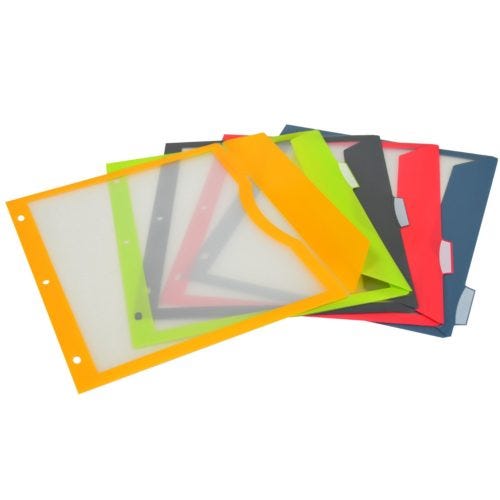Over a decade ago, I wrote a series of posts is intended for people with the cognitive disorder known as brain fog or cloudy consciousness, a common symptom in people who suffer from auto-immune diseases like Lupus or MS, and many other disorders like ADHD. If you have these issues, sometimes the computer as a task or document organizer doesn’t work for you the same as it works for other people.
Some of the organizer tips might be of use to the rest of you, too.
Like this one.
With evangelical enthusiasm, I introduce people to this Perpetual Organizer system, and everyone who uses it loves it.
I started using this when running a small press in the early 1990’s. I had no cognitive disorder issues then and got at least a foot tall stack of mail a day. It kept me on my feet better than anything I’ve ever tried before or since. I’m always willing to try something new, but every time I’ve ditched this for a gadget or any other system (and I tried as recently as last year with disastrous results, like a few late state tax payments,) I have deeply regretted it.
It’s easy and inexpensive to set up. The basics cost less than ten bucks. Upgrade a bit, and it might cost you around $70. Either way works.
Here is what you need. A box or a file cabinet drawer, 31 empty files or folders labeled 1-31 (one for each day of the month,) and 12 files labeled January-December.
Congratulations. You have just set up your perpetual file system. Wasn’t that easy?
Here is how you use it. And why it works better than anything else.
Most systems instruct you to make a daily to-do list. Then you put your bills somewhere. Then you put your plane ticket for your trip out of town somewhere. Then you put your tax paper somewhere. You end up having to go from place to place to find things, and from place to place with your daily list of to-do’s. If you’re the kind of person who has trouble with the pinball machine in your head, this can get rough.
With the Perpetual Organizer, you have a file with the papers you need in the folder on the day you need it instead of in a category where you have to go look for it, and worse, dig through the file to find what you need among all the other stuff.
My system all set up, with commonly used tools and forms in extra pockets.
Say you are leaving for a trip on the 17th. You don’t put your plane ticket on your desk, or in the travel file, or in your inbox. Your plane ticket is in the file marked the 17th when you need it.
Your quarterly taxes are due. Need a reminder? Put a note in the files marked January, April, and so on. When January hits, all the tasks you need to do in January are in that file. You pull out those notes and put the tasks in the files marked for the day you need to do them. If your tax bill is due on the 15th, to be on the safe side, you don’t put the note in the file marked the 15th. You want to be on time, right? So put it in a file marked the 10th. If you can’t get to it on that day, then you can just move the note up a day.
Your bills, your tickets, your forms, your mail, etc. is always in the place where you need it in a central location under the time you need to do it, instead of a file with a bunch of other stuff you don’t need that day. It’s March. Got a show in October? Put your stuff in the file marked October. It will be there when you need it. At the end of September, you move October to-do’s to the file with the dates of the day you leave. Simple.
I originally set up my Perpetual Organizer as a hanging file system. Hanging files are a little more expensive, so some people would prefer not to use them. But you can get 100 plain file folders for less than ten bucks. If you don’t have a huge amount of stuff to organize, try an accordion file. Some come pre-numbered 1-31, so you’d need a second one for your monthlies.
The Smead desk file sorter divides everything for you by day and month which is great, but has no folders, which is why I don’t use it. If you don’t have to handle a lot of paper, it may be OK for you. But I don’t like how it doesn’t hold my stuff securely, and I can’t carry it around.
I have a lot of paper, and I like my system to work as an office in a box. I put mine in a king sized binder, the kind coupon clippers use. I had one of these for over 15 years, so it was a very good deal at $17. I recently replaced it with this big boy for about $25.
A bright color means you’re less likely to lose it. Important for people with brain fog who tend to have trouble keeping track of their surroundings: common objects disappear into the background like furniture.
As you can see, it has very large clips and opens wide, so there is a lot of room for expansion, which is what I need.
I filled it with this set of folders in bright colors with clear plastic windows and easy to see tabs. Also, I like the flaps that close the folders so my stuff is less likely to slip out.
These are a little more expensive at about $1 each, but any folders will do as long as you can put a tab on it and they hold your stuff. I also like the colors which catch my attention so they don’t blend in to one another.
The big advantage to having your folders in a binder is you can carry your system with you wherever you go. If you are sick and need to work in bed, your office comes with you and you don’t have to root around your studio to find everything you need to do because your binder already has it. If I am going to a show, my papers are in the one file I need on the day I leave: I just take the individual file out and carry it with me.
The binder not only has a handle, it has a shoulder strap in case you want to tug it all along with you.
You can add a few extra folders to fit your needs: for example, I have one in there just for common postage supplies, one just to hold information like frequent traveler numbers, or medical information, prescriptions and emergency phone numbers, and my insurance card. You may want to have one for passcodes, or extra sets of keys.
The trick is to use the system daily. It’s a really simple routine, and easy to follow.
Need to make a phone call on a particular day? Drop a note with the phone number and time in the file. Have an interview? Drop a note in the file. Deadline? Book due on the 15th. Put notes in the files daily to remind you as you count down. New project starting? Stick the script in the file on the day you start. Birthdays? Your mom’s birthday is in October. The reminder is always in the October file. You put a note in the file marked the 9th to tell you to buy a present, a note in the file marked the 12th to remind you to go to her party. You can make a daily schedule master list on your computer to drop in your files for those usual tasks.
People who use tech gadgets are looking at this like “Duh, just put it all on your iPhone calendar”. But I already back up a lot of this on my computer, and at least half the time, if it’s only on my computer, I screw it up. Hand written notes and tangible backups, like this Perpetual Organizer, are of great help to people with cognition issues.
Even if you don’t have problems along those lines, this system helps you keep it together.
I am not perfect. I make mistakes. Usually when I am feeling better and think “I don’t need to do that today.” Then I let my routine slip, and I regret it later because when I am not feeling well, I don’t have the energy to fix my mistakes. So keep up your routine. You’ll be grateful you did.
The Perpetual Organizer won’t solve all your problems, but I have never used anything that works better.
I’ve stopped using this system a few times because I am always looking to reinvent the wheel. Every time I come crying back to it for forgiveness. Nothing works for me as well. I back it up by also saving files on the computer.
When I first wrote this series, I had an undiagnosed auto-immune disorder. Now that I get proper treatment, I don’t have the brain fog issues I used to.
But I also know that I could have a relapse or need a medication adjustment in future (several times as of this writing,) so staying organized is a must.
Just a couple of weeks ago, I wasn’t even able to tell you what week it was, I was that out of it. It can be really rough.
The only time I had trouble maintaining this system was years ago when I was broke and paying all my bills by mail. They could really pile up in that file! And on the day I couldn’t pay one, I’d move it to the next day. And the next. And then there’d be more bills in the next file. It got rough. Thankfully, those days are gone.
Someone asked me where I got the idea. I have no memory of that, it’s not unique to me. My twist on it (and I am sure other people also figured this out) was to put it in a binder for portability and add other features, like a pouch for mailing supplies and other folders for commonly used medical and travel info. I also have a folder for things like time sheets.
Of course, what works for me may not work for you. If you have any suggestions, add them in the comments so others may learn!









OMG I had to read the paragraph regarding what you get two or three times before my brain went… wait she is talking physical file folders. I love it
Tip I have for people that struggle making sure they pay all their monthly bills each month. (I used to) is I set up an Excel spreadsheet and on the left are all the people/companies I pay each month plus add the one off things like taxes. Across the columns I set up the months. 2 columns per month, one for the $ the other for the date. If I haven’t paid it yet I highlight the field yellow so it stands out. I have not missed a payment since starting this. Also makes it easier to have a feel for how much I am spending each month as almost everything is in there. No more late fees 😀
Because in Belgium nearly all must do's (tax returns, invoicing, payments, travel documents, concert tickets,..) are paperless, I just put a note in my outlook calendar on the day action is needed. With, if needed, a link to the email or website where the info for the action can be found. If I need to postpone something, I just move the note to the new day. Works great for me (and I have all I need always with me on my phone or laptop). And no, I'm not tech savy but I hate to print everything (I hate printers) so this is a perfect solution.